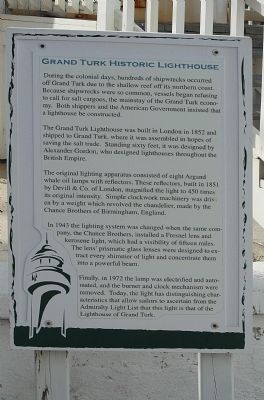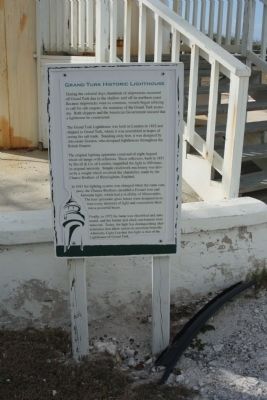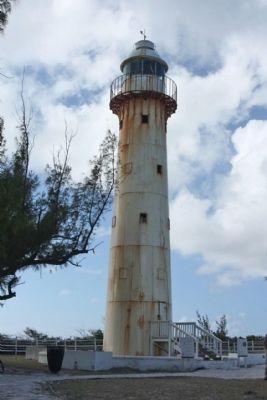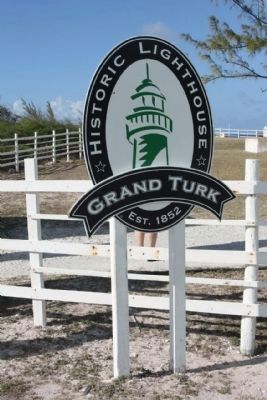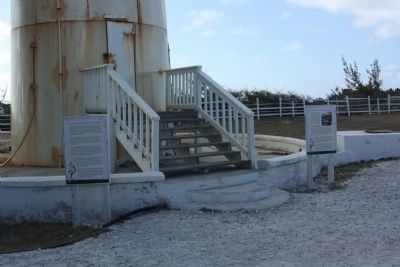Cockburn Town in Grand Turk, Turks and Caicos Islands, British Overseas Territories — North Atlantic Ocean
Grand Turk Historic Lighthouse
The Grand Turk Lighthouse was built in London in 1852 and shipped to Grand Turk, where it was assembled in hopes of saving the salt trade. Standing sixty feet, it was designed by Alexander Gordon, who designed lighthouses throughout the British Empire.
The original lighting apparatus consisted of eight Argand whale lamps with reflectors. These reflectors, built in 1851 by Devill & Co. of London, magnified the light to 450 times its original intensity. Simple clockwork machinery was driven by weight which revolved the chandelier, made by the Chance Brothers of Birmingham, England.
By 1943 the lighting system was changed when the same company, the Chance Brothers, installed a Fresnel lens and kerosene light, which had a visibility of fifteen miles. The lens' prismatic glass lenses were designed to extract every shimmer of light and concentrate them into a powerful beam.
Finally, in 1972 the lamp was electrified and automated, and the burner and clock mechanism were removed. Today, the light has distinguishing characteristics that allow sailors to ascertain from the Admiralty Light List that this light is that of the Lighthouse of Grand Turk.
Topics and series. This historical marker is listed in these topic lists: Industry & Commerce • Man-Made Features • Waterways & Vessels. In addition, it is included in the Lighthouses series list. A significant historical year for this entry is 1852.
Location. 21° 30.686′ N, 71° 8.007′ W. Marker is in Cockburn Town, Turks and Caicos Islands, in Grand Turk. Marker is on Lighthouse Road, in the median. Located at northern terminus of Lighthouse Road at Lookout Point . Touch for map. Marker is in this post office area: Cockburn Town, Turks and Caicos Islands 00109-9000, British Overseas Territories. Touch for directions.
Other nearby markers. At least 8 other markers are within 5 kilometers of this marker, measured as the crow flies. A different marker also named Grand Turk Historic Lighthouse (a few steps from this marker); The Northeast Reef (within shouting distance of this marker); Grand Turk: The Original Columbus Landfall ? (within shouting distance of this marker); Lighthouse Keeper's Residence & Bermuda Kitchen (within shouting distance of this marker); Horatio Nelson Lookout Point (within shouting distance of this marker); Trouvadore Shipwreck (about 90 meters away, measured in a direct line); U.S. Naval Facility (about 120 meters away); The History of the West (approx. 4.7 kilometers away). Touch for a list and map of all markers in Cockburn Town.
Regarding Grand Turk Historic Lighthouse. Reactivated (1998); focal plane 33 m (108 ft); white flash every 7.5 s. 18 m (60 ft) cast iron tower, painted white, attached to kerosene storage house. A 4th order Fresnel lens (1943) from the lighthouse is on display at the Turks and Caicos National Museum. The keeper's house and kitchen also survive. The lighthouse was prefabricated in London by Chance Brothers; it is a very rare example of this early design in cast iron. After many years of neglect, the lighthouse was partially restored in 1998. In 2006, Carnival Corp., the cruise line holding company,
granted funds to repaint and refurbish the lighthouse,keeper's cottage,and other light station buildings. This was part of much larger investment to develop Grand Turk as a regular stop for cruise ships. Grand Turk suffered considerable damage from Hurricane Ike in September 2008 the lighthouse survived (though it needed repainting). Located at the northern tip of Grand Turk Island; accessible by road. .
Site open, tower closed. Site manager: Turks and Caicos National Trust. ARLHS TCI-001; Admiralty J4812; NGA 12408.
Also see . . . Argand & Lewis Lamps. There is some disagreement as to who was the first to place parabolic reflectors behind Argand's lamp to further boost and concentrate the output. H L. Reynaud, Director of the French Lighthouse Service, credited Aimé Argand himself with the first proposal for an apparatus using an Argand lamp and a reflector. This combination represented a considerable improvement over current illumination systems, and quickly came into widespread use in European lighthouses. (Submitted on February 18, 2011, by Mike Stroud of Bluffton, South Carolina.)
Credits. This page was last revised on June 16, 2016. It was originally submitted on February 18, 2011, by Mike Stroud of Bluffton, South Carolina. This page has been viewed 2,536 times since then and 36 times this year. Photos: 1, 2, 3, 4, 5. submitted on February 18, 2011, by Mike Stroud of Bluffton, South Carolina.
